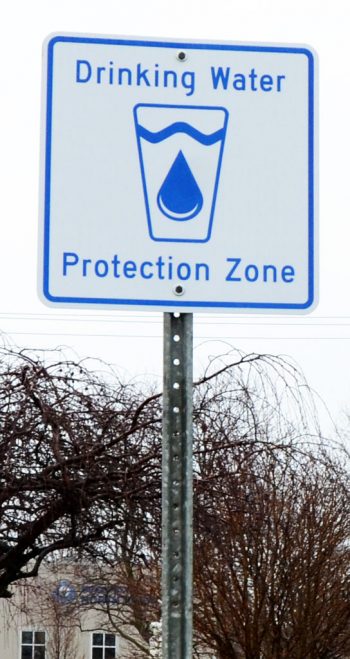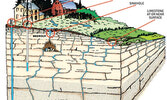By Mel Luymes
Near Lion’s Head, Finley Cameron looks on as his cattle gather at the large round trough in his summer pasture, just steps away from the banks of Judges Creek, now fenced off. In the past, it was common for cattle to drink at the cool spring-fed creeks on the Bruce Peninsula, but all that has changed. Livestock watering systems like Cameron’s are the new normal on the Peninsula, as farmers work to protect their karst aquifer.
Cameron notes that the cattle much prefer the trough, it is easier for them to drink from. Partnering with the Bruce Peninsula Biosphere Association, with help from local and provincial funding, farmer investments in alternative livestock watering systems are protecting not only surface water, but their groundwater as well.
About 100 kilometres to the south, in the small town of Ayton, residents have been decommissioning their old wells. Without municipal utilities, all residents are on private septic systems and wells. When their wells dried up and they needed to drill deeper, Ron Pfeffer was one of the many residents with abandoned wells on his property. Working in the livestock industry, he was aware of potential groundwater contamination and didn’t think twice about hiring a licensed contractor to decommission his old wells. For him it was about peace of mind, and he was even able to access some cost-share funding from the local Source Water Protection Region.
Rural residents in Ontario depend on private wells for their water; it is often the only water source on a property. Thankfully, most will have access to clean water beneath their property, but this makes it all too easy to take our drinking water for granted.
While some might picture aquifers as underground lakes in giant caves, it would be more accurate to imagine them as layers of sponges filled with water. These sponges are permeable layers of gravel, sand or rock through which water slowly moves, held by more impermeable layers of rock or clay. There are other types of aquifers in which water is held in small fissures within the bedrock itself.
Deep underground, aquifers are genuinely mysterious, but many Rural Voice readers, like Finley Cameron, will find themselves living on the most curious of all, a karst bedrock aquifer. While any aquifer can be vulnerable to contamination in certain places, karst is unique and can be quite vulnerable in certain areas.
What is karst?
To understand karst, we need to go way back to a time that southern Ontario was covered in shallow seas. The remains of sea creatures and coral became layers of limestone and dolomite rock, and as the seas disappeared, they left the rocks exposed to rain. Being slightly acidic due to carbon dioxide in the atmosphere, the rains began to slowly wash away the softer limestone layers of this sedimentary rock. Over time, it carved (and is still carving!) vertically and horizontally, creating an underground maze -sometimes as large as rivers and caverns – through which groundwater flows. In some cases, these caverns destabilized the rock above to collapse and form larger sinkholes.
There are examples of karst aquifers around the world and many in parts of Ontario, but perhaps the most fascinating and beautiful example is the Niagara Peninsula, where its rock layers and caves are visible for all to explore. The Niagara Escarpment stretches from what is now upstate New York to Niagara Falls, up through Ontario, across Michigan’s Upper Peninsula and down to Green Bay, Wisconsin. The Escarpment formed because the rock layers gently sloped towards the middle of the old sea, and a more resistent layer (a bathtub ring of sorts) formed a cap that protected the softer layers underneath.
Glaciers sculpted the rest of the landscape, grinding, transporting and depositing it in various places across the province as they advanced and then melted into our Great Lakes. The sediment the glaciers left behind we call glacial till. This is a layer in the soil profile in which rocks, gravels, sands, silts and clays are all mixed together, unsorted. While wind and water will sort soils by their particle size, glacial till looks like a dog’s breakfast and it is still compacted from the weight of a mile thick ice sheet. This till is a restrictive layer in the soil, which creates and protects aquifers, and is also the reason much of Ontario’s soils are classified as improperly drained and required tile drainage systems in order to be farmed.
But just because much of the older karst landscape is covered in soils (or ‘overburden’), doesn’t mean it isn’t down there . In some some places there are tens of metres of soils and sediment protecting the karst aquifer from what’s happening on the surface. But in other places, there may be only a few feet, or inches, if that. And that’s where things get tricky.
Farmers on the Peninsula know it well. Karst is close to the surface there and can swallow a stream whole; surface water disappears into the ground like into a storm sewer, only to resurface a few kilometres away. Surface water can become groundwater and vice versa. And travel times of groundwater flows through karst aquifers means that water quality can change quite quickly, so these areas require an extra level of precaution.
Protecting drinking water
For some, May of 2000 will seem like a lifetime ago, but for many Rural Voice readers the Walkerton Tragedy will still hurt like it was yesterday. Lest we forget, or for our younger readers, an improperly treated municipal well was contaminated by intense rains that followed a spring manure application. Half of the town got sick from their tap water, and seven people died. It was a literal watershed moment that forever changed the way we think about groundwater in Ontario. Within a few years, we saw the introduction of four new pieces of legislation to protect public health.
First, the Safe Drinking Water Act implemented strict drinking water standards and greater authority to provincial inspectors, along with mandating training, accountability and public transparency. Next, the Sustainable Water and Sewage Systems Act mandated municipalities to assess full costs for water and sewage services, so they couldn’t cut corners on public safety in order to buy votes. Third, the Nutrient Management Act set guidelines for storage, handling and application of manure and other nutrients, requiring many farms to create a management plan or strategy to eliminate over-application.
Lastly, the Clean Water Act mandated the protection of municipal water sources, creating protection zones and involving local stakeholders. It created Source Protection Authorities and initiated Source Protection Committees in 19 regions of Ontario that roughly follow watershed boundaries and work closely with Conservation Authorities. The Act appointed Risk Management Officials (RMOs) who co-develop Risk Management Plans with property owners within protection zones.
The Grey Sauble Risk Management office is located at Grey Sauble Conservation’s headquarters outside of Owen Sound, and there, RMOs Carl Seider and Karen Gillan are responsible to safeguard public drinking water from the Saugeen Watershed to Northern Bruce Peninsula. Gillan grew up on a beef farm and now lives and farms in the area; she works especially on communications and community engagement. Seider has had plenty of experience working with the provincial government in emergency spill response, flood and water related issues. While there were many more employed in their office while the program was being developed and protection zones were created from 2006 to 2015, it is now primarily just the two of them.
These maps are now online (search “Source Protection Information Atlas”), and you’ll see that each protection zone’s area is different, depending on local hydrogeological features and where each municipality gets its water.
Groundwater wells have a Wellhead Protection Area (WHPA) and Zone A is regulated 100 metres around the wellhead. Zone B delineates a travel time of two years to the intake and risk manages farming activities, fuel and chemical storage and waste disposal. Zone C has fewer restrictions to land use but may still require some regulation, especially for dense, persistent chemicals like degreasers and wood-strippers.
Surface water intakes have Intake Protection Zones (IPZ) with similar but much larger protection zones because, in some cases, a fuel spill could reach municipal water in only a matter of hours.
Seider and Gillan work proactively within these protection zones; since 2007 two million dollars of provincial funding has supported businesses, residents and landowners in Grey and Bruce Counties to make necessary upgrades to storages, septic systems, etc. They believe that a voluntary approach with stewardship grants has been very cost-effective and complementary to the regulatory approach and has done more to get public buy-in and support in the long run as well.
The local source protection program is currently working on a study in the Kimberley and Shallow Lake areas to more accurately understand groundwater flows through karst systems. The goal is to re-map the protection zones for municipal wells in Kimberley and Shallow Lake in order to better protect the towns’ groundwater supplies. These areas have been recognized as vulnerable to surface water and sinking steams that can impact drinking water sources.
What about private wells?
It is important to note that these Source Water regulations only protect municipal water sources and do not currently have jurisdiction on private wells, which are instead regulated by Ontario Water Resources Act, Regulation 903. Under this legislation, landowners are responsible for any wells on their property; they must be installed by a licensed contractor or to the specific quality standards in the Act. These involve specifications on depth and diameter, casing and proper sealing for new wells, as well as protection of the wellhead and minimum distance separation from potential contaminants.
Private well standards, ongoing inspection and maintenance and proper decommissioning by licensed contractors are important because wells can be impacted by surface contaminants and in some cases can themselves be a direct pathway of contamination into the very aquifer they are drawing from.
A recent example of private well contamination occurred in Wiarton, when livestock wintered in a wet, karstic area, forcing the family to find an alternative drinking water source. This isolated example, along with others from the US, has spurred a Grey County resident to raise the alarm to local councils and call for a local Task Force on karst groundwater, as well as restricting severances, additional private wells and certain farming activities. 
With the public understandably concerned, Dr. Hugh Simpson was asked to give a presentation to Bruce County Council. Recently retired from the Ministry of Agriculture, Simpson worked closely with the agricultural community after the Walkerton Tragedy and helped develop the Ministry’s best management practices for groundwater and private wells. He now works with the University of Guelph’s Morwick G360 Groundwater Research Institute.
On October 3rd, Simpson addressed the Council and community concerns with regards to vulnerable aquifers. He emphasized the importance of private well owners being involved in protecting their water supplies: designing, installing and upgrading wells properly, regular water testing and treatment as needed, as well as proper decommissioning of abandoned wells. He outlined the current resources available to municipalities and rural residents and is currently working with community and technical partners across the province to update these materials and research better ways to convey technical information to the stakeholders that need it.
Best practices for private wells
For rural landowners reading this, it is important to know that your well is your responsibility and one to be taken seriously. As Karen Gillan outlined in the September Rural Voice issue (see Grey County Federation of Agriculture), there are several things that rural residents can do to protect water for themselves and their neighbours.
First is to do regular water testing. Sampling bottles are available through local Health Units and the testing is completely free, with results available in a matter of days. Water treatment is an option for homes, as UV, reverse osmosis or other filtration is quite affordable these days.
Regular assessment of the quality of the wellhead and casing is important. Residents can self-assess their property with even just a shovel to find the depth to water or to bedrock in various locations. Soil texture also matters for water quality, with smaller particles (clay) providing the best protection.
Next, assess for proximity to risks from manure, fertilizers, ensilage run-off, septic systems, fuel or chemicals. Proper storage and handling of these materials, regular inspection of septic systems, along with proper setback from wellheads, watercourses, rocky outcrops or hollows on the property will go a long way to protecting groundwater aquifers, karst or otherwise.
There are assessment tools available from the Ministry of Agriculture, within the Environmental Farm Plan and Nutrient Management Plans. A series of rural groundwater factsheets are also available online from the Ministry of Agriculture (search for “Understanding Groundwater”) which includes a well maintenance checklist. Furthermore, the Ontario Federation of Agriculture and Farm & Food Care Ontario (then the Ontario Farm Environmental Coalition) created a comprehensive Farm Source Water Protection Framework that is useful for farmers. Local Health Units are also a great source of information about water quality and the Ontario Ground Water Association has a list of licensed well drillers in the province that can provide their expertise.
Rural residents have a vested interest in protecting their groundwater, not only for now but for future generations. In this case, as in most, an ounce of prevention is worth a pound of cure. Whether it means replacing a failing septic system, improving a manure storage, fencing cattle away from a stream, or decommissioning an abandoned well, we all have our part to play to protect our groundwater aquifers. ◊


